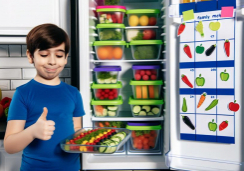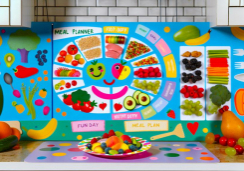Trusted Tips for Picky Eater Meal Strategies
You've likely faced a mealtime standoff that could rival any historic siege when trying to coax a picky eater to try a new dish. It's a familiar battle for many parents and caregivers, but fear not; there are strategies that can arm you with the tools to gently negotiate peace and nutrition at the dinner table.
As a seasoned expert, you know that transforming a picky eater's habits doesn't happen overnight—it's a culinary journey. You'll need to understand why your child might be reluctant to try new foods, and how to introduce changes without causing a rebellion.
You're about to learn how to create a positive mealtime environment, the importance of routine, and ways to involve your child in the process, which can all make a huge difference. But where do you start, and how can you implement these strategies in a way that's both effective and respectful of your child's preferences?
Stay tuned, as the following discussion unfolds the blueprint to navigate this tricky terrain with finesse and patience.
Establishing Mealtime Routines
To foster a sense of predictability and ease mealtime struggles, it's crucial to establish a consistent eating schedule that aligns with the rest of the family's meals. Crafting mealtime routines is the cornerstone of peaceful family meals. As you work on establishing mealtime routines, aim for three meals and three snacks spread consistently throughout the day. This structure not only provides a reliable framework for your child but also ensures regular nutrient intake for growth and development.
Family meals are opportunities to encourage your child to explore new tastes and textures. Serve the same healthy food you're eating to everyone, which reinforces the idea that there are no separate 'kid meals' and 'adult meals.' Including at least one food your child likes can make meals less daunting, making them more likely to eat or try other items on the plate.
Furthermore, involving your child in meal preparation can transform mealtime battles into collaborative efforts. It's a chance for them to feel invested in what they're eating. Remember, the goal isn't to force-feed but to gently encourage your child to be curious about their food. Consistency, positivity, and patience are key in nurturing healthy eating habits.
Introducing New Foods
Building on the foundation of established mealtime routines, introducing new foods to picky eaters can be a gradual and rewarding process that benefits their nutritional diversity and palate development. As you continue to nurture your child's healthy eating habits, keep in mind that patience and persistence are your allies in this journey.
When you're ready to make unfamiliar foods a part of your kids' meals and snacks, remember that they're more likely to try new options when they're offered alongside their favorite dishes. Here's how to encourage your picky eaters to embrace a variety of tastes:
- Offer the food repeatedly: Kids may need multiple exposures before they warm up to a new food.
- Serve in different ways: Presenting the food in various forms might reveal a preferred preparation.
- Pair with favorites: Introduce new foods alongside well-loved ones to make them less intimidating.
- Stay patient: Accept that acceptance of new foods mightn't happen overnight.
- Be persistent: Consistent offering without pressure can lead to eventual liking.
Use these Strategies for Picky Eaters to gently expand their palates. With time, your children are more likely to try new foods, ensuring they receive a balanced and varied diet.
Creating a Positive Environment
Encouraging your child to take part in meal preparation can foster a sense of curiosity and positivity toward eating, especially when fun and colorful dinnerware is part of the experience. By involving your child in meal prep, you're not only making food fun but also offering healthy options in an engaging way. This can help reduce mealtime stress and avoid power struggles, as your child feels more in control and invested in what's being eaten.
Setting a routine for when meals and snacks occur is crucial. It ensures that your child is hungry and ready to eat, making them more likely to try new foods. Eating together creates a positive environment and allows for role modeling, where you can show by example the joys of healthy eating.
Encouraging Self-Selection
Giving children the freedom to select their own foods from a variety of wholesome options can empower them to make independent choices and explore new tastes at mealtime. Encouraging self-selection is a powerful tool in promoting a positive relationship with food. When you let your child have a say in what they eat, you're not only making mealtime more appealing but also teaching them to make healthy food choices.
To facilitate this process, consider these strategies:
- Offer a colorful variety of healthy options for your child to choose from.
- Involve your child in meal planning and preparation to pique their interest.
- Allow your child to serve themselves, reinforcing autonomy and portion control.
- Encourage your child to try at least one bite of everything, but don't force it.
- Make sure your child sees others enjoying the same foods, which might entice them to join in.
When you come to the table with this approach, you're setting the stage for a less stressful and more successful mealtime. You can't always make your child eat certain foods, but by offering a range of nutritious choices and modeling enjoyment, you increase the chances that your child will eat a balanced diet.
Addressing Snack Timing
While empowering your child to make their own food choices is important, it's equally crucial to establish a regular schedule for meals and snacks to maintain their appetite and interest in mealtime. By serving food every 2-4 hours, you help your child manage hunger and provide a structure that makes trying new foods less daunting. Consistent snack times can also assist in preventing overeating and ensure that your picky eater is ready to eat when meals are presented.
Make sure to stand firm on not offering snacks outside the predetermined times, especially if your child has skipped a meal and is asking for food. It's tempting to give in, but holding out encourages them to feel hunger and look forward to the next mealtime, where they might be more willing to try new foods.
If a snack is necessary, offer a small portion of fruits or vegetables. These healthy foods not only fulfill immediate hunger but also provide essential nutrients without spoiling their appetite.
Frequently Asked Questions
What Are the 5 P's of Picky Eating?
You're dealing with picky eating, so remember the 5 P's: Patient persistence, Positive reinforcement, Portion sizes, Peer modeling, and Playful interaction. They encourage trying new foods in a supportive, family-friendly way.
How Do You Feed an Extremely Picky Eater?
To feed an extremely picky eater, use creative presentation and texture exploration. Pair flavors, provide positive reinforcement, and manage hunger. Model good eating, ensure a stress-free environment, educate on taste, and introduce foods gradually during fun cooking sessions.
What Is the SOS Approach for Picky Eaters?
The SOS approach encourages you to create a non-pressure environment for sensory exploration, using food play and gradual introduction to teach tastes and textures, with positive reinforcement and peer modeling during family meals for effective child involvement.
How Do You Make a Meal Plan for a Picky Eater?
To make a meal plan for a picky eater, you'll mix balanced variety with texture exploration. Use creative presentation tactics and flavor pairing, disguise ingredients, and establish a mealtime routine focused on nutrient density and positive reinforcement.
Conclusion
In conclusion, you've got this! Establish routines, persistently introduce new foods, and foster a joyous mealtime atmosphere. Encourage your child's choice-making and mind their snack times.
Remember, it's about nutritious, shared meals that build trust and health. If in doubt, a dietitian's expertise can be invaluable.
Stick with it—your dedication supports your picky eater's growth and well-being, strengthening family bonds along the way.
Cheers to happy, healthy family mealtimes!










